We are hiring! Run with Riesterer and Schnell: Apply Today


We are hiring! Run with Riesterer and Schnell: Apply Today
Search
Choose a Location

Price: $27,790
Monthly Payment: $430
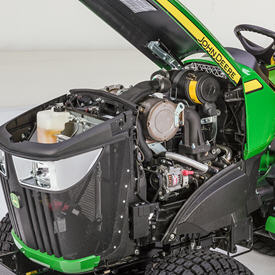
3025E
The 1.642-L (100.2 cu in.) displacement, liquid-cooled 3TNV88F-EPJT1 Yanmar diesel engine provides 18. kW (24.4 hp) to the 3025E.
| Model | Number of | Engine | Rated rpm | Gross engine hp* | Gross engine ps* | PTO hp |
| 3025E | 3 | 1.642 L (100.2 cu in.) | 2400 | 18.2 kW (24.4 hp) | 24.7 | 14.4 kW (19.4 hp) |
*Engine kW (hp), gross SAE J1995: 18.2 (24.4) at 2400 rpm, PS
Displacement, L (cu in.): 1.642 (100.2)
3032E
The 1.642-L (100.2 cu in.) displacement, liquid-cooled 3TNV88C-NJT Yanmar diesel engine provides 22.9 kW (30.7 hp) to the 3032E.
| Model | Number of | Engine | Rated rpm | Gross engine hp* | Gross engine ps* | PTO hp |
| 3032E | 3 | 1.642 L (100.2 cu in.) | 2500 | 22.9 kW (30.7 hp) | 31.2 | 18.6 kW (25 hp) |
*Engine kW (hp), gross SAE J1995: 22.9 (30.7) at 2500 rpm, PS
Displacement, L (cu in): 1.642 (100.2)
3038E
The 1.568-L (95.68 cu in.) displacement, turbocharged, liquid-cooled 3TNV86T-NJT Yanmar diesel engine provides 27.4 kW (36.7 hp) to the 3038E.
| Model | Number of | Engine | Rated rpm | Gross engine hp* | Gross engine ps* | PTO hp |
| 3038E | 3 | 1.568 L (95.68 cu in.) | 2500 | 27.4 kW (36.7 hp) | 37.3 | 22.4 kW (30 hp) |
*Engine kW (hp), gross SAE J1995: 27.4 (36.7) at 2500 rpm, PS
Displacement, L (cu in.): 1.568 (95.68)
The engine uses the latest technologies to optimize fuel economy, improve control and accuracy, and reduce environmental impact. The common rail system (CRS) optimizes fuel economy and reduces operating costs*. High-pressure injection atomizes fuel into finer particles which burn more completely. It results in improved fuel economy and a lower cost of operation.
The electronic control unit (ECU) provides optimum fuel control and accuracy. ECU monitors and controls the engine. It continuously monitors engine conditions and adjusts the fuel delivery accordingly to ensure optimum performance and emissions.
The engine comes with an after-treatment system. The system operates automatically. The exhaust filter consists of a diesel particulate filter (DPF) which captures particulate matter (PM) contained in the exhaust gas. Using a natural cleaning process, most of the PM trapped in the exhaust filter is eliminated by the heat of the exhaust stream generated by normal use. In situations of low temperature, engine speed, or load factor, an active cleaning cycle is initiated. In this cleaning cycle, the exhaust gas temperature is raised by injecting additional fuel during the exhaust stroke of normal vehicle operation to the diesel oxidation catalyst (DOC).
After many hours of use, the exhaust filter may require an ash removal service.
*NOTE: As compared to engines not using CRS technology.
Depending on the load that the tractor is under, as well as ambient temperature, humidity, and engine speed, the DPF may build up with particulate matter, thus requiring cleaning. Filter cleaning is determined by one of three factors:
Once one of the three conditions has been met, filter cleaning will occur.
There are three different types of filter cleaning processes:
Passive filter cleaning
Passive filter cleaning occurs naturally when the engine is generating enough heat to oxidize particulate matter. This automatic process occurs continuously during normal operating conditions. No tractor icons or symbols appear on the display during passive filter cleaning.
NOTE: Passive filter cleaning requires no operator involvement, and there is no interruption to tractor operation.
Active filter cleaning
If conditions (temperature, load, or speed) for passive filter cleaning cannot be achieved, then PM is removed using active filter cleaner.
To achieve the required conditions, exhaust temperature management (ETM) manages the initiation and duration of active filter cleaning. ETM can adjust numerous engine parameters and/or inject a small quantity of fuel into the exhaust stream for a short duration. The fuel turns to vapor and chemically reacts with the catalysts in the DOC to create heat to oxidize the PM.
It is important to note that at no time is the fuel in the DOC/DPF ignited, and there is no flame within the DOC/DPF.
Like passive filter cleaning, active filter cleaning requires no operator involvement, and there is no interruption to tractor operation.
In some instances where passive and active filter cleaning have not fully cleaned the PM from the system, a parked filter cleaning may need to take place. In general, the only time a parked filter cleaning will need to occur is when automatic filter cleaning has been disabled for an extended period of time and multiple warnings to engage filter cleaning were ignored or if the tractor has been used during light load conditions. Additionally, when the automatic filter cleaning process has been deliberately interrupted multiple times, or if active filter cleaning has failed numerous times due to a failed component, a parked filter cleaning may be requested. In these rare instances the operator will have to park the tractor and start the filter cleaning process.
The parked filter cleaning process needs to be activated based on usage and operation of the tractor. The process will take approximately 30 minutes. See the operator's manual for more details.
This system constantly monitors the soot level of the tractor; making sure the tractor is always in peak performance condition. This ensures high performance at all times.
NOTE: Number of hours since last regeneration and soot level percentage are viewable on LCD display.
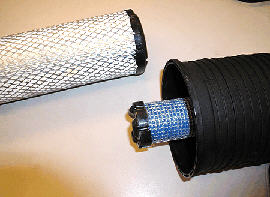 Dry-type air cleaner
Dry-type air cleaner 
Yanmar is a trademark of Yanmar Company Limited.
The 3E Tractors are available with a two-range hydrostatic transmission (HST) incorporated in a die-cast aluminum transmission case. Fluid under pressure transmits engine power to the drive wheels via a closed-loop pump and motor arrangement. Infinite ground speeds allow the operator to match the speed of the tractor to the job.
Safety features of the HST include:
 Twin Touch foot controls
Twin Touch foot controls Key John Deere advantage - John Deere's Twin Touch foot controls offer several key advantages over competitive HST models tractors.
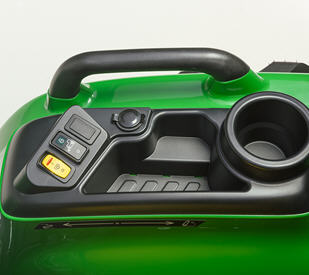 Optional cruise control
Optional cruise control The 3E Series Tractors can be outfitted with an optional cruise control switch that is installed on the right-hand control console. This gives operators the ability to keep a constant speed when in transportation, field mowing, or other applications where extended use of the transmission is needed. This kit is very quick and easy to install for those who desire this feature.
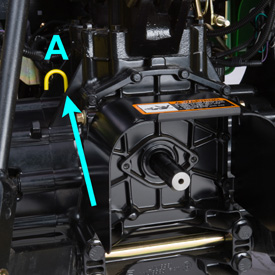 Transmission reservoir fluid checkpoint (A)
Transmission reservoir fluid checkpoint (A) 
 Transmission fill point
Transmission fill point 
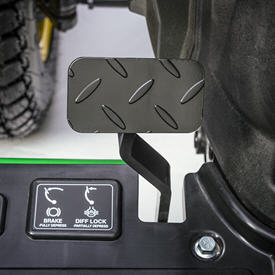 Integrated brake and differential lock pedal
Integrated brake and differential lock pedal
Sauer-Danfoss is a trademark of Sauer-Danfoss Incorporated.
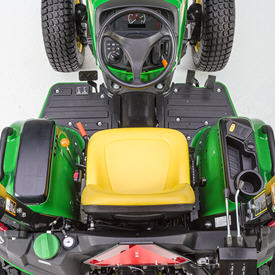 Clean and simple operator's station
Clean and simple operator's station An uncluttered design gives operators of all sizes plenty of room to be comfortable. Color-coded controls are located on either side of the operator.
Operator presence system:
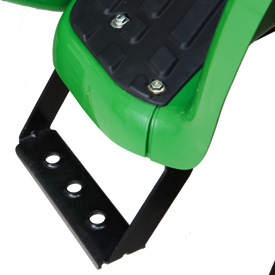 Left-side step for easy entry/exit
Left-side step for easy entry/exit 
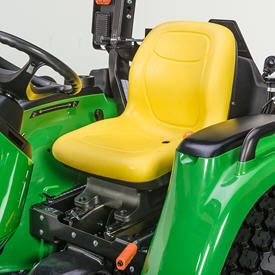
The thick, soft padding on this seat provides a smooth and comfortable ride.
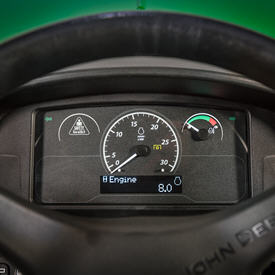 Instrument panel
Instrument panel Easy-to-read instrument panel includes the following:
 Fuel gauge
Fuel gauge All 3E Series Tractors come standard with a fuel gauge that is easy to read from the operator's station, to ensure operators do not run out of fuel.
Operator presence switch (OPS) in seat:
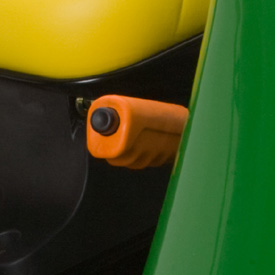 Park brake
Park brake 
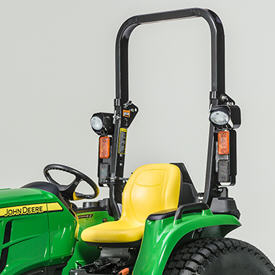 Roll-Gard ROPS
Roll-Gard ROPS 3E Series Tractors are equipped with Roll-Gard ROPS. These folding ROPS meet the ASABE standards for compact utility tractors.
NOTE: The use of seat belts is recommended at all times when operating the 3E Series Tractor with folding ROPS.
An optional canopy is available to help protect the operator from the elements.
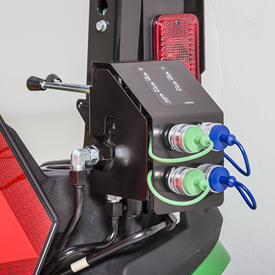
3E Series Tractors can be equipped with a field-installed rear hydraulic remote kit, providing two additional hydraulic spools on the back of the tractor. This kit can be field installed on a tractor with a loader or without a loader.
The functions are completely separate from the loader. These rear remotes can be hooked up to a wide variety of implements and attachments such as follows:
This versatile kit gives 3E Series Tractor operators the options they desire for putting their tractors into a wide range of tasks.
The first spool is equipped with a float position, giving the operator the ability to contour the landscape and improve the final grade with certain implements.
NOTE: Neither of the spools in this kit are equipped with a detent position; therefore, they should not be hooked up to anything with a motor, as the valve was not designed to be run open. The kit is designed for momentary, on-demand hydraulic flow such as moving a cylinder.
The approximate installation time is 1 hour to 1.5 hours.
 iMatch Quick-Hitch
iMatch Quick-Hitch 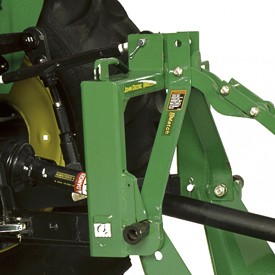 iMatch Quick-Hitch with rotary cutter hookup
iMatch Quick-Hitch with rotary cutter hookup 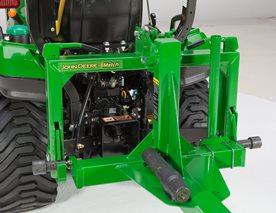 iMatch Quick-Hitch (LVB25976)
iMatch Quick-Hitch (LVB25976) 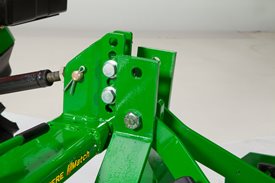 iMatch Quick-Hitch with rotary cutter hookup (LVB25976)
iMatch Quick-Hitch with rotary cutter hookup (LVB25976) One of the greatest operator concerns involves difficulty in attaching tractor implements. John Deere has addressed this issue with the iMatch Quick-Hitch.
The iMatch Quick-Hitch provides easy hookup and a guaranteed fit for all Category 1 implements that are designed to meet the American Society of Agricultural and Biological Engineers (ASABE) Category 1 Standard S278.6 for quick-attach hitches.
NOTE: The bushing set can be seen in the picture above. These bushings allow the hooks on the iMatch and the pins on the implement to fit together properly. All other implements (box blades, tillers, rear blades, etc.) will require a set of bushings to enlarge the pin to fit with the iMatch hooks. Bushings of different lengths can be found in the parts system or through a bushing supplier (see dimensions below).
Regular service and maintenance are essential to the performance, productivity, and longevity of the tractor.
 |
 |
 |
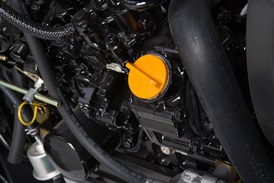 Removable side panels (previous model shown)
Removable side panels (previous model shown) All items in the daily service schedule can be performed without the use of tools:
NOTE: Always refer to the operator's manual for complete maintenance and service recommendations.